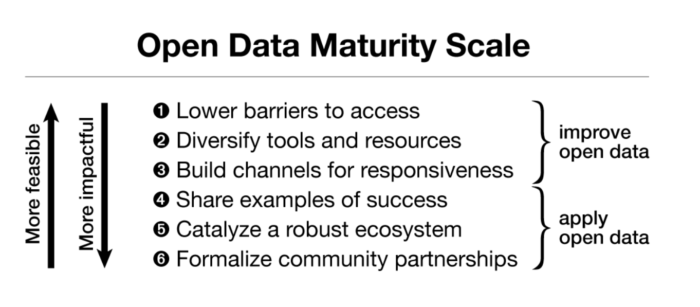An open data maturity scale for cities to find right-sized solutions
Local governments are often ambitious when it comes to innovating around open data and civic technology — they envision highly developed tools and open data products that will change the way communities solve problems. But sometimes open data projects fall flat because of any number of challenges: data isn’t usable, data is hard for users to find, data is presented at the wrong skill level, data is shared through the wrong forum or platform.
We use Tactical Data Engagement (TDE) to help local governments find current and potential open data user needs and then collaborate with community members to co-design and execute an open data intervention to support their needs. But across cities and towns that we’ve worked with, open data providers have been at widely varying stages of progress when it comes to preparing open data for community use.
Most local governments we work with need help deciding what kind of intervention to pursue. They need to know: a) how much time and effort they should expect to invest in an open data project, and b) what impact different levels of investment might have in the community.
We created the Open Data Maturity Scale to help local governments better understand their readiness to use and apply open data for community impact.
Local governments, or any other data providers using the scale, can learn what it looks like to support a high feasibility-short impact project vs. low feasibility-long impact project. Most often, decision-makers are looking for something in the middle. For example, some interventions might be highly feasible and foundationally important, but could have a minimal immediate impact. Conversely, other interventions might be more difficult to implement, and require deeper, longer-term investments for governments to see results.
What type of interventions fit at each maturity level?
- Lower barriers to access
The most feasible and foundational intervention open data providers can take is to release robust, meaningful public data based on community information needs. Read more about taking first steps to lower barriers to access on our Open Data Policy Hub.
- Diversify tools and resources
Once open data is out there, data owners can try doing user research and finding out what tools, data improvements, or resources would supplement basic open datasets, like producing new standardized data, creating data visualizations, or publishing contextual how-to guides.
The Western Pennsylvania Regional Data Center publishes Data User Guides. The City of Madison has a Data Toolkit for nonprofits to use open data when applying for City grants.
- Build channels for responsiveness
Local governments should expect that even once open data is up, they’ll have to continue changing and improving open data offerings. Responsiveness is a key element of building trust to convince residents that providing feedback will inspire action.
The City and County of San Francisco publishes statistics about open data use and allows residents to submit open data issues. The City of Chattanooga created a chat bot to answer questions about open data.
- Share examples of success
Often, civic hackers, journalists, and other community data users aren’t sure how open data should be applied to solve local challenges. Showcasing successful open data applications from partners can help show users how they might use open data for local issues.
The City of Charlotte shares links to tools that partners have developed using City open data. The City of Cambridge publishes a Civic Innovation Challenge Inventory to show what success using data could look like, or what problems open data might solve.
- Catalyze a robust ecosystem
Investing in the local community of data users can help people feel that local governments will support their efforts to innovate with open data. Community-building events or challenges can help catalyze local data users to participate in local issues.
The City of Boston issued a data challenge to get residents to use open data to better understand their communities. Many cities have Chief Data Officers or Chief Innovation Officers who regularly participate in local civic hacking groups.
- Formalize community partnerships
The best way to support the growth of the open data and civic tech user community is to fund or provide in-kind support to groups that are facilitating impactful efforts. Establishing formal pathways for collaboration can help residents have sustainable, prolonged access to decision-making and local problem-solving that is powered by open data.
The City of New York solicited residents to apply to become Borough Open Data Ambassadors. The City of Tulsa has an Urban Data Pioneers program for residents to work alongside government staff to solve problems. The City of Chicago co-founded the Smart Chicago Collaborative with local philanthropists and the Chicago Community Trust to work on civic tech and digital inclusion issues.
Before using this Open Data Maturity Scale, local governments should review our TDE Discovery methods, which show decision-makers how to understand what data residents need and why they need it. But when it comes time to take Action, local governments need to know where they are and where they’re going when it comes to expanding their work open data. By using this Maturity Scale, open data innovators can navigate the many potential opportunities to apply open data to generate the impact they’d like to see.


